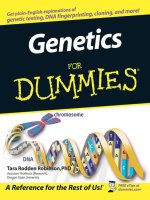Electroculture 101 1st edition
Bạn đang xem bản rút gọn của tài liệu. Xem và tải ngay bản đầy đủ của tài liệu tại đây (21.6 MB, 48 trang )
1ST EDITION 2023
DEREK DEAN MULLER & YANNICK VAN DOORNE
ELECTROCULTURE 101
A Starter Guide to Electric Gardening
Derek Dean Muller
&
Yannick Van Doorne
1st Edition | 2023 | WWW.ELECTROCULTURE.LIFE | CHELAN, WA
ILLUSTRATION BY: DEREK DEAN MULLER - YANNICK VAN DOORNE - FRAPPREAU ADRIEN - DAVID WECHSLER
What is Electroculture?
Introduction
Electroculture is a group of techniques that
uses electricity + magnetism to amplify plant growth.
Plants grow bigger and faster with higher nutrient
values. Over time, this simple technology can
eliminate the need for toxic pesticides and fertilizers.
Magnetoculture is synonymous with
electroculture. In nature, magnetic and electrical
forces always manifest conjointly. Magnetoculture
refers more specifically to magnetic influences and
electroculture to electric influences on plant
growth and soil fertility. Together they harness the
electromagnetic / atmospheric energies that are
flowing all around us and essential for life.
With electroculture techniques, the energy and vitality of your soil will increase
each year for the first 3 to 5 years to become highly fertile and eventually
constant for decades to come. Here are just some of the many benefits:
Effects on Soil Effects on Plants
+ Improved soil structure + Accelerated growth
+ Better growth of aerobic bacteria + Increased crop yields
+ Improved nitrogen fixation + Enhanced flowering
+ Enhanced nutrient mobility + Production of larger fruits
+ Increased microbial reproduction + Increased sugar content
+ Enhanced microbial metabolism + Protection against insects
+ Access to more nutrients + Improved disease resistance
+ All-around better soil + Reduced need of fertilizer
6
How it Works
Atmospheric
Electricity
The electric field of the Earth
increases in intensity as you
move up in elevation, so while
at ground level the strength of
electric field in the air may be
100 Volts/meter (V/m), as you
go further up in elevation the
atmospheric electricity grows
stronger.
Electoculture Coil Spiral Magnet
Systems Helical
Pyramid Tower
There are many types of systems
that can be made with simple
materials like copper, galvanized
iron/steel wire, aluminum wire,
metal tubes, magnetic rocks,
piezoelectric crystals & magnets.
This guide will cover the basics.
Fun Fact The first electroculture patent was filed in 1920 by French inventor
Justin Christofleau. Germany offered 12 million Francs for the world’s
rights to his invention, but he declined... & now all the world can benefit.
7
The Results
Controlled Studies
There is much evidence to show the effects
and success of electroculture, documented
by farmers and researchers all over the
world. One of the modern pioneers is
Yannick Van Doorne. See his research at
www.electroculturevandoorne.com
Control Electroculture
8
Yannick Van Doorne
COILS &
ANTENNAS
Lakhovsky Coils
The Lakhovsky Coil
The Lakhovsky coil consists of a simple single-loop coil of wire with
open ends, best oriented to the North. This helps to improve the growth
of plants and/or heal them from various forms of disease. These coils are
effective in a variety of environments and many people have achieved
amazing success by applying them to individual plants and trees.
Fun Fact In 1929, George Lakhovsky published the book “The Secret of Life”. He
discovered that every living thing has an electromagnetic field. Plants,
humans, puppies, water, everything. This effect is known as resonance.
11
Lakhovsky Coils
How It’s Made
Step 1: Prepare copper loops with approx 3ft of
wire per loop. Leave space between the ends of the
wire. The loop can be overlapping as long as there is
about a 1” gap between the ends (not touching).
Step 2: Secure these ends to wooden stakes
approx 6-12” above the soil, suspended around the
base of the plant. To improve the antenna effect it
works best with the open ends facing the North.
Step 3: Tilt the copper loop in a 30° angle so that
the highest point of the loop is facing the South. (Wire
can be placed on the ground if insulated/enameled)
The opening of the coil
(capacitance section) works
best aligned with the natural
geomagnetic flow of energy
12
Lakhovsky Coils
Multi-Coils
Lakhovsky coils have many
applications, and more than one
coil can be applied to a single
plant, person or living thing.
These coils are made with any
size of insulated, enameled or
bare copper wire. Also, multiple
wires can be twisted together
for amplified effects.
S N
Coils also work
underground and
around the roots
Fun Fact The discoveries of George Lakhovsky were actually intended to show the
effects of electromagnetic energy on the human body, but early in his
research he used plants to prove his thesis. Same same, but different.
13
Spiral Antennas
The Ighina Spiral
These are Luigi Ighina spirals invented from the pioneer and genius who
studied under Marconi (inventor of the radio). Ighina discovered how to
cure cancer cells with vibrations but was never recognized as an orthodox
scientist by the academic community. Rather, he was either ignored or
ridiculed for his work.
Ighina discovered that snails receive special atmospheric energies with the
spirals on their shells. This gave him the idea to experiment with these kinds
of spirals making antennas. Aluminum wire works well for this technique,
but materials like copper, iron, steel and other metals can work too.
14
Spiral Antennas
Snailed It!
The right way to make spirals is always
clockwise rotation from the top to the
bottom. However, the conical shape
does not have to be perfect. There are
many different shapes of snails and they
all seem to work to harness this energy.
Cosmic Earth
Energies Energies
- Flowers - Vegetative
- Seeds Growth
Bigger spirals (or multiple spirals) When the point of the cone is directed to
will collect more energy and have a the cosmos, it will collect more cosmic
greater influence on the plants. energies good for flowers and seeds.
When you point it to the earth, then it
will collect more earth energies and
improve more vegetative growth.
For balanced plant growth, the best is to
put a spiral in each direction, one to the
earth and one to the sky, connected to
the soil directly or with wire wrapped
around a stick/post going into the soil.
Fun Fact Many people have also found success by simply placing snail shells
around their garden and even into the soil, which naturally has the same
geometry and beneficial effects as the antennas.
15
Spiral Antennas
Size = Frequency
The size and shape of an antenna
determines its resonant frequency.
So different size spirals will attract
different frequencies of signals into
the soil biome and ultimately to your
plant’s roots. Experiment to observe
which resonant frequencies your
plants respond to the most.
Electroculture works with many of the same principles as Nikola Tesla who
once said “If you want to find the secrets of the universe, think in terms of
energy, frequency and vibration.”
16
Underground Magnets
The Earth Magnetic Antenna
Developed by French electroculture researcher,
Yannick Van Doorne, Earth Magnetic Antennas
essentially take the magnetic force generated by a
set of cylindrical magnets, and drive that force
down a wire (South to North). The material of the
wire must be galvanized and ferromagnetic
metal (iron or steel), so classic galvanized wire as
used in agriculture for trellising or fencing is well
suited and easily found. A single magnet can
charge up to 100ft of wire or more. Beeswax is a
natural cosmic antenna which brings in energies
and frequencies to the antenna system, especially
when first treated with frequencies of 432 Hz.
Fun Fact The power of 432 Hz was recognized by the most noted ancient
civilizations. The musical instruments of ancient Egypt which have been
dug up so far, all have been reported to be tuned to this said frequency.
18
Underground Magnets
How It’s Made
Step 1: Simply pass galvanized wire through the center
of the cylindrical magnets and secure it to the South end of
the wire with a beeswax covering (to amplify the effect).
Step 2: Install the system 1-3ft below the soil in a South
to North orientation. All the soil is charged in a 3ft radius
around the wire. North (+) end of magnet should face North.
The two most common types of permanent magnets are ceramic (ferrite) seen
above, and neodymium (shiny silver) which is more expensive and not adapted
for this application. Galvanized wire is best for systems that include magnets.
Stainless steel also works, but only if it’s magnetic (test with a magnet).
19
Lightning Rod Antenna
The Lightning Rod
The Lightning Rod Antenna combines all
these materials to maximize its potential.
The antenna is installed onto a post that is at
least 6ft tall and can also be connected to an
underground wire (running North) that is
effective up to 300ft or more.
6-20ft
The taller
the better
Combining different types of Ground
metals allows the antenna to wire
receive different types of
energies. The more types of
energies you can harness, the
better the results.
The “easy way” is simply wrapping
metal wire to secure rods into place
Fun Fact There are about 2000 thunderstorms taking place on Earth at any
moment and approximately 50 lightning events every second. Each
event creates electromagnetic waves that travel across our planet.
20









